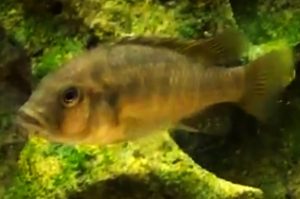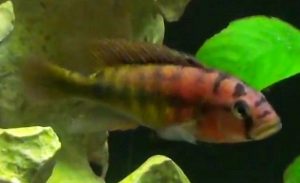The Jordan Mouthbrooder (Haplochromis flaviijosephi or Astatotilapia flaviijosephi) is the only haplochromine cichlid whose natural range is not in the continent of Africa. It is found in rivers, freshwater lakes, and freshwater springs in Israel and Syria, and because of habitat loss, is considered endangered.
There are a small number of isolated populations in the waters surrounding the Sea of Galilee, the Baisan Valley, Azraq Oasis, Lake Tiberias, and Lake Muzairb which may be considered sub-species.
Little is known about the Jordan Mouthbrooder in Syria, but all of the sub-populations are considered threatened. In Israel, there are 4 or 5 populations that currently exist in lakes and rivers, but extreme droughts, pollution, and loss of water has resulted in a decline in habitat quality. All populations are found in shallow, vegetated waters.
The Jordan Mouthbrooder is basically a silvery tan colored fish with twelve faintly visible vertical bars running along the sides of the fish. The fins are mostly transparent, but dominant or breeding males undergo an almost spectacular color transformation.
The pelvic fins and entire underside of the males turn a jet black, and two to three large orange “egg spots” appear on the anal fin and cross the fin rays. The bottom lip becomes a bright blue color and a distinct black bar appears at the top of the eye socket and continues forward and downward past the corner of the mouth into the black throat.
The head and rest of the body is a tan color with a slightly reddish tinge, and an orange splotched area begins around the base of the pectoral fin and continues rearward to the caudal peduncle.
When stressed, both sexes exhibit dark blotching along the flanks but males are much darker and brightly colored than females.
Adult male Jordan Mouthbrooders can reach a length of over 5″, with females being slightly smaller. Males can be distinguished from females by their diet and teeth. Males posses molariform teeth and feed mainly on snails, while juveniles and females posses slender, blade like teeth and feed on insects, small echironomid larvae, oligochaetes, and amphipods.
Jordan Mouthbrooders can be housed in a 30 gallon or larger aquarium with a medium sandy or gravel substrate, some plants such as Anubias, a few rocks, and a piece of driftwood if desired. Moderate filtration and bi weekly water changes are recommended to keep the water as pristine as possible.
Astatotilapia flaviijosephi are maternal mouth brooders that are reportedly relatively easy to breed. They are seasonal spawners that in their native waters reproduce several times from April to July.
The females gestate the young for around two weeks at a temperature of 82° F. Males court the females by fanning out a pit in the gravel at the base of a rock where spawning occurs. When the male entices a gravid female into the pit with a series of shimming gyrations, spawning takes place and the male leaves the female to fend for herself.
The female will find a spot to brood her developing young and for up to two days after release, she will continue to allow the free swimming fry into her buccal cavity. After this period, the female will continue to protect the area around her fry, but she will not allow them back into her mouth.
Jordan Mouthbrooders are a carnivorous species that do well on a variety of fresh and frozen foods. Commercial carnivore pellets, flakes, and granules can be used as a staple diet, with regular offerings of fresh, frozen, or freeze dried bloodworms, brine shrimp, mysis shrimp, etc.
Because Astatotilapia flaviijosephi is regarded as endangered, it is unlikely that any will ever be available in a tropical fish keeping shop or online any time soon. Obtaining specimens from breeders is possible through worldwide cichlid organizations.
Minimum Tank Size: 30 gallons
Care Level: Difficult
Temperament: Semi Aggressive
Aquarium Hardiness: Hardy
Water Conditions: 68-84° F, dH 18-30, pH 7.0-9.0
Max. Size: Males 5″+, Females 4″
Color Form: Silver, Tan, Black
Diet: Omnivore
Compatibility: Single species tank or other eastern cichlids
Origin: Israel and Syria
Family: Cichlidae
Lifespan: 5 years +
Aquarist Experience Level: Intermediate




